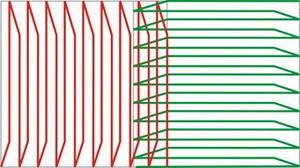Search the Community
Showing results for tags 'jagged'.
-
You can often see a machine embroidery defect where an outline pulls in the stitches of the bottom layer and the fabric becomes visible. Or there is a gap between the objects where the stitches run in the same direction. Or a gap between the design and the outline made with running stitches. Avoiding these may seem a hard task. But in reality, it is not so. Means have been invented long ago, beginning with choosing the right kind of stabilizer and hooping method, and concluding with foreseeing the possible damage at the digitizing stage and taking measures to avoid it. I'll skip the hooping methods and the choice of the stabilizer. Let's highlight the simple digitizing recommendations. If you have the neighboring objects where stitches run in the same direction, a digitizer should apply pull compensation. It is necessary for the needle not to make multiple penetrations at the joining places that result in huge holes. If the fabric is also not stable enough, you may get a huge gap like the one in the second photo. Compensation settings depend on the type of fabric to be embroidered, the density of the machine embroidery design, stitch length, and other parameters. But the usual advice is to overlap the objects at least by 1–2 mm. When the objects adjoin and the stitches in them run parallel, you should split the objects in order to avoid bulging. This means creating a distance between the objects no less than 2 rows of stitches. This gap will be closed during the embroidery due to push deformation of both objects in the stitch direction. If two objects where stitches run in opposite directions adjoin, you may have to tackle this problem: too much pull compensation may result in the ridge at the place where the two objects overlap. There may be several possible outcomes: if a green object is embroidered last, the stitches on its edge will become interlinked with the ones in the lower red layer and pulled to the side, separate from the fill. The longer are filling stitches, the more probably they will be pulled under the upper layer, leaving the gap and revealing the fabric. In order to avoid that, you'll need to add an underlay at the place where two objects join. Low-density satin with a jagged edge will be sufficient. Thus, even if the stitches will end up under the upper layer, you'll see not the fabric, but the underlay. If the direction of the stitches in the upper, red layer, is perpendicular to the one in the green layer, no deformation will occur. The stitches in the red layer work as a bridge in this case. Therefore, no preventive measures should be taken. Running stitch outline is believed to be the most difficult in machine embroidery – it allows of no mistakes. In case a mistake takes place, the outline immediately goes off the track. There are only 2 ways of avoiding a gap between the outline and the design: the first is to spare the outline altogether, and the second is to overlap the fill and the running stitch outline. That's why I mentioned that digitizing should begin with the image analysis. You can see the potential problems at this stage and avoid them while digitizing.
- 2 comments
-
- 1
-

-
- overlap
- digitizing
-
(and 3 more)
Tagged with:


